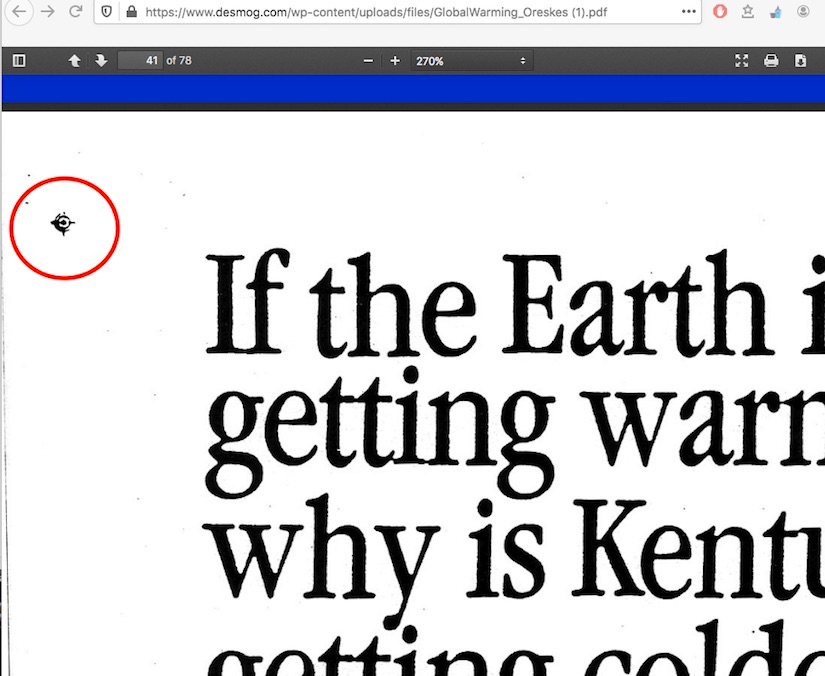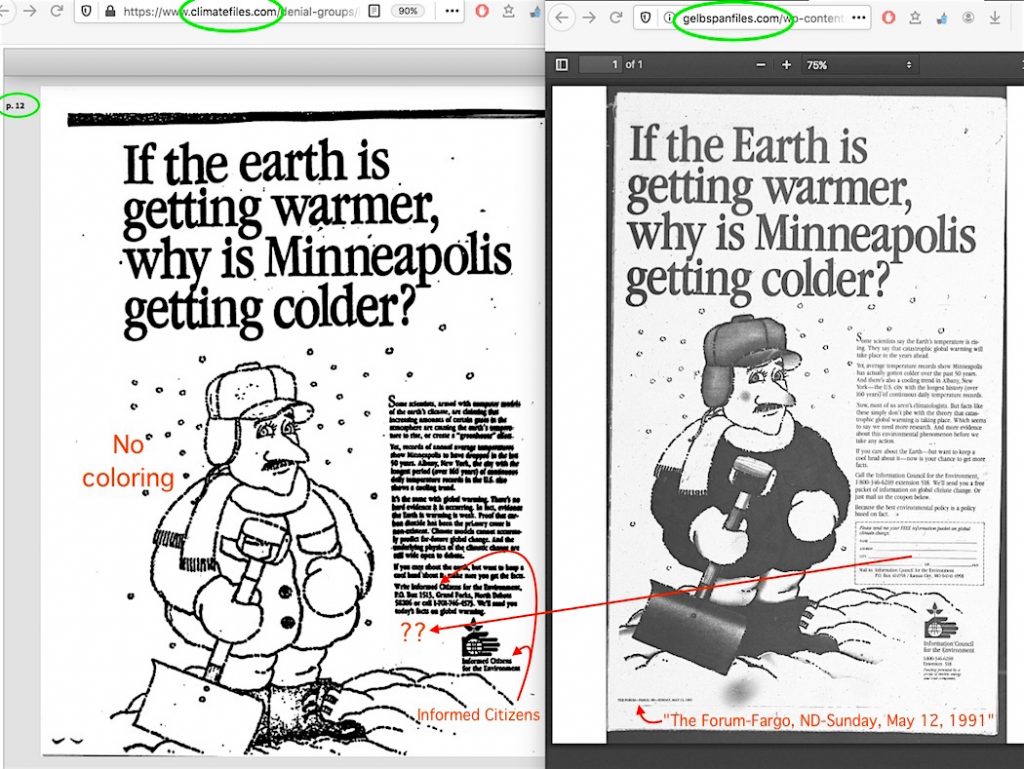I could have just as easily titled this post “The First, the Last, and the Only Accusation Against Global Warming Skeptics, redux” or “Put all your Eggs in the ‘Reposition Global Warming as Theory’ Memos Basket, redux,” since what’s going on lately is pretty much exactly that. Give Naomi Oreskes credit for her most recent co-authored effort at the UK Guardian to infuse the ‘fossil fuel industry-led disinformation campaigns’ accusation with a new shot of ye olde “reposition global warming” memos, complete with a pair of never-used ads with the unsolicited, never-used “Informed Citizens for the Environment” labels. Her credibility suffers just that much more every time she attempts to incorrectly glue that name over the actual “Information Council for the Environment” (ICE) public relations campaign. Incrementally worse now, her Guardian article’s citation of Kert Davies’ Climate Files website as her source for the two never-used ads only ends up digging a deeper hole for herself and Davies, along with any others who keep making the mistake of drawing attention to those alleged ‘disinformation’ ICE ads as smoking gun evidence of fossil fuel deception efforts.
My latest screencapture links illustrate how these folks don’t provide tidy answer on whether the fossil fuel industry deceived the public about the ‘harm’ of man-caused global warming; their clumsy inconsistent narratives seem to point a giant arrow in the other direction on where all the disinformation is in the political accusation side of the issue.
My examination here picks up on the overall “leaked ICE memos collection missing pages, A.W.O.L. from public view, popping out of the woodwork” problem, for lack of a better description. I briefly mentioned that problematic contradictory page tally situation at the very end of my Part 1 blog post on the genuine ICE newspaper advertorials.
How big is the “leaked ICE memos collection”? Well, who knows how many pages were in the original pile that was “circulated around Washington D.C.” in June 1991? Perhaps either or both the New York Times and the Sierra Club might provide their piles if subpoenaed to do so. The same answer might arise from finding an original set of the memos available from the old Ozone Action group in 1996 — notice in their “proposed advertisements” section in that screencapture that they list four ICE ads: “Most serious” / “Minneapolis colder” / “Chicken Little” / Earth flat.” Four, not three.” That’s important for the next bits here.
When I first dived into the smear of skeptic scientists in late 2009, plenty of internet references were made to the “reposition global warming” memo set, Newsweek, (notice the Oreskes/Minneapolis-Kentucky ads ref in that screencapture), US News & World Report, etc, but nobody ever linked directly to the memos. It took me seven months of digging before I was able to make sense of Australian activist Sharon Beder’s cryptic reference to Ozone Action, and that’s what led me to Greenpeace USA’s* arguably be-all end-all 50-page collection. (* I must use the Internet Archive link to show their collection; ironically Greenpeace, which long demanded transparency from industry people, apparently let their vast “Research” scans collections pages lapse into offline non-public access around mid-February, 2021. My own PDF downloaded copy of those 50 pages is here)
Greenpeace oddly kept the page 1 Ozone Action cover, which correctly named the PR campaign as the “Information Council for the Environment” while incorrectly attributing the “reposition global warming” memo subset to the ICE campaign there. The parts of the rejected memo subset proposal from the Edison Electric Institute are scattered among those 50 pages; the never-used “Informed Citizens” and the never-implemented “reposition global warming” strategy are on pages 9/10, and the rejected, never-used suggestion for audience targeting is on page 17. But the thing I want to draw particular attention to in this exercise is Greenpeace’s final three pages of their 50 page collection — very blurry, scratchy copies of the alleged “Most serious” / “Chicken Little” / “Doomsday cancelled” ads. Zoom way in on those last two, and you see the never-used “Informed Citizens” name. Again, this was the largest single collection of alleged ICE documents ever on the internet, from its June 2007 upload to its February 2021 disappearance.

The “Minneapolis-Kentucky colder” ads, referenced in the August 2007 Newsweek article, are not in that collection. How would Newsweek have been able to refer to those, then?
Part of the possible explanation comes from Naomi Oreskes’ notorious 2008 Powerpoint presentation titled “You Can Argue with the Facts” (handily archived at Desmog, likely in early 2016 among many others, as an online-viewable PDF). She dutifully regurgitates ye olde “reposition global warming” phrase in her slide 27, and in her slide 34, she distinctly demonstrates knowing the official name for the ICE campaign. But what does her 2008 PPT show in slides 41 to 45? The same “Chicken Little” ad that’s similarly cropped at the bottom like the one at Kert Davies’ 2016-era ClimateFiles ICE ads page (both apparently have identical photocopy dust marks) ….. and four other ads never seen in the Greenpeace collection, including the “Kentucky colder” one that was mentioned at Newsweek. What’s a particular small, but critically noteworthy detail in that one? There’s a pre-print production registration mark in the top corner.

The “Solve problem” one has those, too. The “Flat earth” ad has the never-used “Informed Citizens” name in two places.
If someone strives to show how a particular industry public relations effort deceived the public, isn’t it incumbent on the accuser to show material that was actually seen by the public? But wait, there’s more.
Prior to teaming up with Naomi Oreskes to ‘research’ the history of ‘fossil fuel disinformation campaigns, Geoffrey Supran (the other co-author of the UK Guardian “Forgotten Oil Ads” article) was a self-admitted anti-fossil fuel industry activist at the Massachusetts Institute of Technology. As one of the apparent leaders of the “Fossil Free MIT” efforts, he put out a 2014 press release about it, and the accompanying report featured at least the mostly correct official name for the ICE campaign, along with three ads attributed to the campaign. The citation source for the ads was not from Greenpeace’s collection, which predate Naomi Oreskes’ entry into the issue by as much as a decade; the source was instead Oreskes’ 2008 PPT presentation … for the “Chicken Little” / Flat earth” ones with their never-used “Informed Citizens” words, and the “Solve problem” one with its pre- print production registration marks.
Skip ahead to the midsummer 2017 time when Kert Davies’ (ex-Ozone Action / Greenpeace staffer, don’t forget) finally shared scans uploads to his “1991 Information Council on [sic] the Environment Climate Denial Ad Campaign” Climate Files page to accompany his months-old mentions of the “Chicken Little” and “Doomsday cancelled” ads – the pgs 48 & 49 previously at the Greenpeace scans along with Greenpeace’s terrible version of the “Most serious” ad — correct?
Yes. But among his 27 Climate Files pages of ‘campaign-specific’ scans are the three Greenpeace ad scans …. and one more, page 12, that was never in the Greenpeace scans. In the PDF downloadable file of his 27 scans, the “Most serious” ad on page 9 and the other two are as blurry and scratchy as ever, but that ‘new’ ad page scales in significantly larger. It’s the other half of the “Minneapolis-Kentucky colder” ads referenced a decade earlier in the Newsweek article that quoted Naomi Oreskes. And it has a bigger problem than just that. Compare it to the final publicly-seen Fargo North Dakota newspaper printed one I showed in my Part 1 blog post — Kert Davies’ version is a pre- print draft version with no coloring, and it’s missing the clip-out coupon:

So, where did that one come from? And if someone strives to show how a particular industry public relations effort deceived the public, isn’t it incumbent on the accuser to show material that was actually seen by the public? Plus, if some example of that effort did appear in public, what assurance do we actually have that proves the industry execs knew it was false information but deliberately put it out anyway?
Meanwhile, skip ahead now to just last September 2020 for the BBC “How the oil industry made us doubt climate change” article. They actually assign the proper official name to the ICE campaign, but dutifully regurgitate ye olde never-implemented “reposition global warming” memo phrase while still technically correctly attributing it to the Edison Electric Institute …. and then they feature Naomi Oreskes directly quoting the “Kentucky colder” ad, while showing both it and a version of the “Serious problem” ad that is vastly more clear than the one from Greenpeace’s scans. The “Kentucky” had has lost its pre- print production registration mark while gaining stray hairs.
So ….. where did those two ad versions come from — with their quite clear “Information Council for the Environment” words??
Meanwhile, back to Guardian article where we started out in this post. Barely eight paragraphs into it, Oreskes and Supran are spreading disinformation despite proclaiming themselves to be experts on the topic, while Supran oddly seems to claim ownership of the article. The “Informed Citizens for the Environment,” under that specific name, never existed. The official name the public saw, which I have already proved in my Part 1 blog post (and will reinforce with 1st-generation scans from the Arizona and Kentucky newspapers in Part 3) was the “Information Council for the Environment” (ICE). It was a very short-lived pilot project public relations campaign undertaken by the Western Fuels Association, designed to counter the propaganda that Al Gore was putting out in the early 1990s. Neither the “Chicken Little” newspaper ad, nor the “Doomsday” ad, are indicated by official ICE documents to have been printed in any publication anywhere, and as I’ve detailed more than once here at GelbspanFiles, the “Reposition global warming as theory (not fact)” strategy was an unsolicited memo set proposal to Western Fuels, it was rejected, and therefore was never implemented by any energy company anywhere as guidance for running disinformation campaigns.
A tough question arises out of this entire exercise: is Naomi Oreskes possibly actually an expert on the driving reason why people on her side of the accusation need to keep forcing the incorrect “Informed” name onto the actual ICE campaign, and is she actually an expert on where the entire full set of leaked memos – missing pages and all – came from in the first place, who leaked and/or acquired them? Is she actually an expert on who it was who masterminded idea that the “reposition global warming” memo subset was the critically important “shiny distracting object” that would cause the public to dismiss skeptic climate scientists out-of-hand forever, and who originated the idea that the ICE ads could be employed in “Exxon Knew”-style lawsuits** to such an effective enough manner that at least one Attorney General would be dazzled into regurgitating bits about them in public interviews?
————————————————————————
** There’s always more: in that screencapture from her 2012 La Jolla workshop, are those Western Fuels ads also the same WFA docs she says she was alerted to at AMS archives by Anthony Socci, ex-Senate staffer associate of Al Gore? Should Gore be subpoenaed to find out if his set of leaked docs is bigger than the Greenpeace scans pile? Meanwhile, have a look at Part 3,* Part 4 for skeptic readers who demand to know if the “Chicken Little” / “Doomsday cancelled” / “Flat earth” ads did not appear in the Flagstaff Arizona and Bowling Green Kentucky newspapers. *Part 3 covers a new problem.
